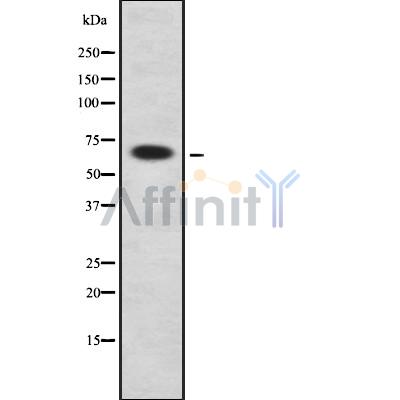NR5A2 Antibody - #DF8470
| Product: | NR5A2 Antibody |
| Catalog: | DF8470 |
| Description: | Rabbit polyclonal antibody to NR5A2 |
| Application: | WB |
| Reactivity: | Human, Monkey |
| Prediction: | Pig, Zebrafish, Bovine, Horse, Sheep, Rabbit, Dog, Chicken, Xenopus |
| Mol.Wt.: | 65 kDa; 61kD(Calculated). |
| Uniprot: | O00482 |
| RRID: | AB_2841702 |
Related Downloads
Protocols
Product Info
*The optimal dilutions should be determined by the end user. For optimal experimental results, antibody reuse is not recommended.
*Tips:
WB: For western blot detection of denatured protein samples. IHC: For immunohistochemical detection of paraffin sections (IHC-p) or frozen sections (IHC-f) of tissue samples. IF/ICC: For immunofluorescence detection of cell samples. ELISA(peptide): For ELISA detection of antigenic peptide.
Cite Format: Affinity Biosciences Cat# DF8470, RRID:AB_2841702.
Fold/Unfold
Alpha-1-fetoprotein transcription factor; B1-binding factor; B1F; B1F2; CPF; CYP7A promoter-binding factor; FTF; FTZ F1; FTZ F1beta; FTZ-F1; FTZ-F1beta; hB1F 2; hB1F; hB1F-2; Hepatocytic transcription factor; Liver receptor homolog 1; LRH-1; LRH1; Nr5a2; NR5A2_HUMAN; Nuclear receptor subfamily 5 group A member 2;
Immunogens
A synthesized peptide derived from human NR5A2, corresponding to a region within the internal amino acids.
Abundantly expressed in pancreas, less in liver, very low levels in heart and lung. Expressed in the Hep-G2 cell line. Isoform 1 and isoform 2 seem to be present in fetal and adult liver and Hep-G2 cells.
- O00482 NR5A2_HUMAN:
- Protein BLAST With
- NCBI/
- ExPASy/
- Uniprot
MSSNSDTGDLQESLKHGLTPIGAGLPDRHGSPIPARGRLVMLPKVETEALGLARSHGEQGQMPENMQVSQFKMVNYSYDEDLEELCPVCGDKVSGYHYGLLTCESCKGFFKRTVQNNKRYTCIENQNCQIDKTQRKRCPYCRFQKCLSVGMKLEAVRADRMRGGRNKFGPMYKRDRALKQQKKALIRANGLKLEAMSQVIQAMPSDLTISSAIQNIHSASKGLPLNHAALPPTDYDRSPFVTSPISMTMPPHGSLQGYQTYGHFPSRAIKSEYPDPYTSSPESIMGYSYMDSYQTSSPASIPHLILELLKCEPDEPQVQAKIMAYLQQEQANRSKHEKLSTFGLMCKMADQTLFSIVEWARSSIFFRELKVDDQMKLLQNCWSELLILDHIYRQVVHGKEGSIFLVTGQQVDYSIIASQAGATLNNLMSHAQELVAKLRSLQFDQREFVCLKFLVLFSLDVKNLENFQLVEGVQEQVNAALLDYTMCNYPQQTEKFGQLLLRLPEIRAISMQAEEYLYYKHLNGDVPYNNLLIEMLHAKRA
Predictions
Score>80(red) has high confidence and is suggested to be used for WB detection. *The prediction model is mainly based on the alignment of immunogen sequences, the results are for reference only, not as the basis of quality assurance.
High(score>80) Medium(80>score>50) Low(score<50) No confidence
Research Backgrounds
Nuclear receptor that acts as a key metabolic sensor by regulating the expression of genes involved in bile acid synthesis, cholesterol homeostasis and triglyceride synthesis. Together with the oxysterol receptors NR1H3/LXR-alpha and NR1H2/LXR-beta, acts as an essential transcriptional regulator of lipid metabolism. Plays an anti-inflammatory role during the hepatic acute phase response by acting as a corepressor: inhibits the hepatic acute phase response by preventing dissociation of the N-Cor corepressor complex. Binds to the sequence element 5'-AACGACCGACCTTGAG-3' of the enhancer II of hepatitis B virus genes, a critical cis-element of their expression and regulation. May be responsible for the liver-specific activity of enhancer II, probably in combination with other hepatocyte transcription factors. Key regulator of cholesterol 7-alpha-hydroxylase gene (CYP7A) expression in liver. May also contribute to the regulation of pancreas-specific genes and play important roles in embryonic development. Activates the transcription of CYP2C38 (By similarity).
Sumoylated by SUMO1 at Lys-270 during the hepatic acute phase response, leading to promote interaction with GPS2 and prevent N-Cor corepressor complex dissociation.
Nucleus.
Abundantly expressed in pancreas, less in liver, very low levels in heart and lung. Expressed in the Hep-G2 cell line. Isoform 1 and isoform 2 seem to be present in fetal and adult liver and Hep-G2 cells.
Belongs to the nuclear hormone receptor family. NR5 subfamily.
Research Fields
· Human Diseases > Endocrine and metabolic diseases > Maturity onset diabetes of the young.
Restrictive clause
Affinity Biosciences tests all products strictly. Citations are provided as a resource for additional applications that have not been validated by Affinity Biosciences. Please choose the appropriate format for each application and consult Materials and Methods sections for additional details about the use of any product in these publications.
For Research Use Only.
Not for use in diagnostic or therapeutic procedures. Not for resale. Not for distribution without written consent. Affinity Biosciences will not be held responsible for patent infringement or other violations that may occur with the use of our products. Affinity Biosciences, Affinity Biosciences Logo and all other trademarks are the property of Affinity Biosciences LTD.
